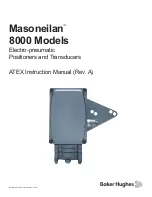
65-2405RK-05-04 Combustible Gas Transmitter • 15
Troubleshooting
The troubleshooting guide describes symptoms, probable causes, and recommended action for
problems you may encounter with the combustible gas transmitter.
NOTE:
This troubleshooting guide describes transmitter problems only. See the controller operator’s
manual for problems you may encounter with the controller.
Table 2:Troubleshooting the Combustible Gas Transmitter
Condition
Symptom(s)
Probable Causes
Recommended Action
Fail
Condition
• Controller
indicates a fail
condition.
• The transmitter
wiring is
disconnected or
misconnected.
• The transmitter’s
zero reading is low
enough to cause a
fail condition.
• The transmitter is
malfunctioning.
1. Verify that the transmitter wiring
is correct and secure.
2. Calibrate the transmitter.
3. If the fail condition continues,
replace the detector.
4. If the fail condition continues,
contact RKI for further
instruction.
Slow or No
Response/
Difficult or
Unable to
Calibrate
• Unable to
accurately set the
zero or response
reading during
calibration.
• Transmitter
requires frequent
calibration.
Note:
Under
“normal”
circumstances, the
transmitter requires
calibration once
every 3 months.
Some applications
may require a more
frequent calibration
schedule.
• The calibration
cylinder is low, out-
dated, or defective.
• The calibration gas
flow rate is too low.
• The calibration gas
is not an appropriate
concentration.
• The transmitter is
malfunctioning.
• The flexible tubing
to the calibration
cup/splash guard has
become kinked,
blocked, or
disconnected.
1. Verify that the calibration cylinder
contains an adequate supply of a
fresh test sample.
2. Verify that the regulator used for
calibration is a 0.5 LPM regulator.
3. Verify that the calibration gas
concentration is appropriate for
the transmitter. The concentration
should be in the detection range,
preferably about half of the
detection range.
4. Verify that the flexible tubing to
the calibration cup/splash guard is
clear and connected to the
calibration cup/splash guard.
5. If the calibration/response
difficulties continue, replace the
detector.
6. If the calibration/response
difficulties continue, contact RKI
for further instruction.







































